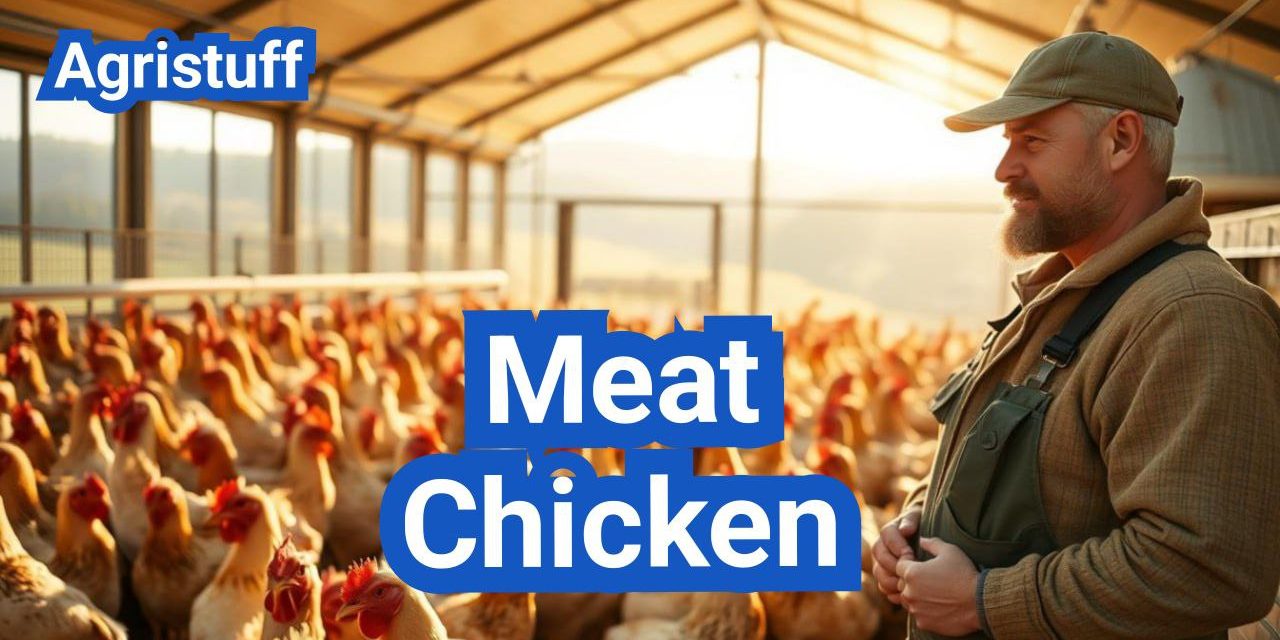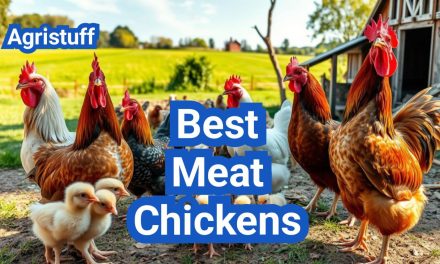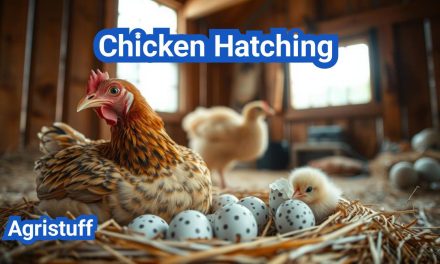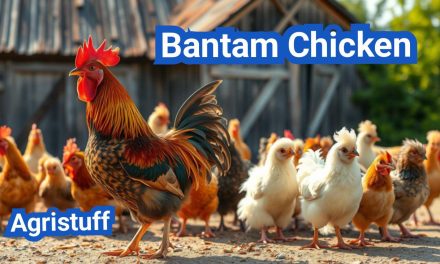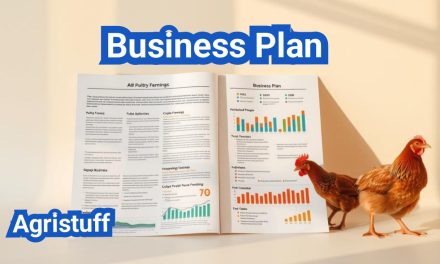Raising meat chicken can be a lucrative business with the right approach. It involves understanding the different breeds, their growth rates, and nutritional requirements.
A comprehensive guide to raising these birds includes selecting the right breeds, such as Cornish Cross chickens, known for their rapid growth rate. Proper housing, feeding, and health management are crucial for achieving high profits in broiler chicken production.
Key Takeaways
- Selecting the right breed is crucial for rapid growth.
- Proper nutrition is key to achieving high profits.
- Effective housing and health management are essential.
- Cornish Cross chickens are a popular choice for meat production.
- Understanding the nutritional needs of your flock is vital.
- Broiler chicken production requires careful planning.
The Profitable World of Meat Chicken Farming
The world of meat chicken farming is both profitable and complex, requiring careful planning and execution. At its core, meat chicken farming involves raising chickens specifically bred for their meat, distinguishing it from egg production.
What Makes Meat Chickens Different from Layers
Meat chickens, also known as broilers, are bred for rapid growth and are typically ready for market in a matter of weeks. Unlike layers, which are bred for egg production and can produce eggs for over a year, meat chickens are optimized for meat production. This difference in purpose leads to distinct breeding, feeding, and management practices.
Key differences include:
- Growth rate: Broilers grow much faster than layers.
- Feed formulation: Broiler feed is optimized for rapid growth, whereas layer feed is formulated to support egg production.
- Lifespan: Broilers are typically harvested within 6-8 weeks, while layers can live for over a year.
The Economics of Broiler Production in the USA
The economics of broiler production in the USA involves a complex interplay of costs, including feed, labor, and capital expenses. Understanding these economics is crucial for profitability.
| Cost Component | Percentage of Total Cost |
|---|---|
| Feed | 60-70% |
| Labor | 10-15% |
| Capital Expenses (e.g., housing, equipment) | 10-20% |
| Other (vet care, utilities, etc.) | 5-10% |
Commercial vs. Backyard Operations
Meat chicken farming can range from small backyard operations to large commercial enterprises. Commercial operations benefit from economies of scale and often have more sophisticated management practices. Backyard operations, while smaller, offer flexibility and can cater to niche markets or personal consumption.
Key considerations for each include:
- For commercial operations: Efficiency, scalability, and market access are crucial.
- For backyard operations: Flexibility, personal control, and potentially higher margins per unit.
Selecting the Best Meat Chicken Breeds

With numerous meat chicken breeds available, selecting the best one for your operation requires careful consideration. The right breed can significantly impact your farm’s efficiency, profitability, and the quality of the final product.
Cornish Cross: The Industry Standard
The Cornish Cross is one of the most popular meat chicken breeds used in commercial poultry production. Known for its rapid growth rate, this breed can reach market weight in as little as 5-6 weeks. Its efficiency in converting feed to meat makes it a favorite among producers looking to maximize profits.
Key characteristics of the Cornish Cross include:
- Fast growth rate
- High feed conversion efficiency
- White plumage, which is preferred in many markets
Freedom Rangers and Red Broilers
For farmers looking for alternatives to the Cornish Cross, breeds like Freedom Rangers and Red Broilers offer slower growth rates but with the benefit of more robust health and better foraging abilities. These breeds are often used in free-range and organic production systems.
Some advantages of Freedom Rangers and Red Broilers include:
- Improved welfare due to slower growth rates
- Better suited for pasture-based systems
- Often preferred by consumers looking for alternative production methods
Heritage Breeds for Specialty Markets
Heritage breeds are gaining popularity, especially in specialty markets where consumers are willing to pay a premium for unique, high-quality products. Breeds like the Plymouth Rock and Wyandotte are known for their rich flavor and firm texture.
Heritage breeds offer several benefits:
- Unique flavors and textures
- Often used in niche marketing strategies
- Can command higher prices due to their specialty status
Black Chickens and Other Exotic Varieties
Exotic varieties, such as black chickens, are also being explored for their potential in meat production. While they may not grow as quickly as some commercial breeds, they offer distinct characteristics that can be marketed to consumers looking for something different.
When selecting a breed, it’s essential to consider your production goals, target market, and the specific characteristics of each breed. By choosing the right meat chicken breed, you can improve your farm’s efficiency and profitability.
Planning Your Meat Chicken Operation
Before diving into meat chicken farming, it’s essential to plan your operation carefully. A well-structured plan will help you navigate the complexities of raising meat chickens, ensuring a profitable and sustainable business.
Determining Scale and Production Goals
The first step in planning your meat chicken operation is to determine the scale of your production. This involves deciding how many chickens you will raise per batch and how many batches you will produce annually. Your production goals should be aligned with market demand and your available resources, including land, capital, and labor.
To determine your scale, consider factors such as your target market, available capital, and the size of your operation. For instance, a small-scale operation might start with a few thousand chickens, while a larger commercial operation could involve tens of thousands.
Batch Planning for Continuous Production
Batch planning is crucial for maintaining a continuous supply of meat chickens to meet market demands. This involves scheduling multiple batches throughout the year, ensuring that you have a steady supply of chickens ready for market at regular intervals.
To achieve this, you need to calculate the optimal batch size and frequency based on your production capacity, market demand, and the growth rate of your chickens. For example, if you’re raising chickens to be harvested at 8 weeks, you might plan batches every 6-8 weeks to allow for processing and preparation for the next batch.
Space Requirements and Site Selection
Adequate space is critical for the health and welfare of your meat chickens. The amount of space required will depend on the scale of your operation and the production system you choose (e.g., conventional, free-range, or organic).
When selecting a site for your operation, consider factors such as accessibility, drainage, and environmental impact. The site should be easily accessible for deliveries and market sales, have good drainage to prevent waterlogging, and be located in an area that minimizes environmental impact.
Legal Considerations and Permits
Meat chicken farming is subject to various legal requirements and regulations, which can vary by location. It’s essential to research and comply with local, state, and federal regulations regarding animal welfare, environmental protection, and food safety.
Some of the legal considerations include obtaining necessary permits, adhering to zoning laws, and complying with health and safety standards. For example, you may need permits for constructing chicken houses or for the disposal of manure.
Essential Housing for Meat Chickens

A well-designed housing system is essential for raising healthy meat chickens and achieving optimal growth rates. Proper housing protects the birds from predators, harsh weather conditions, and diseases, while also ensuring their comfort and reducing stress.
Brooder Setup for Day-Old Chicks
The brooder is a critical component of meat chicken housing, especially during the first few weeks of life. Day-old chicks require a warm, safe, and clean environment to thrive. A typical brooder setup includes a heated enclosure, bedding material like pine shavings, and adequate ventilation.
Key considerations for a brooder setup:
- Temperature control: Maintain a temperature of around 90-95°F (32-35°C) for the first week, gradually decreasing it as the chicks grow.
- Lighting: Provide 24-hour lighting for the first few days to help chicks locate feed and water.
- Space: Ensure at least 0.5-1 square foot per chick to prevent overcrowding.
Designing an Efficient Meat Chicken Coop
As the chicks grow, they need to be transferred to a more spacious coop. An efficient meat chicken coop should be designed with ventilation, ease of cleaning, and bird comfort in mind. The coop should protect the birds from predators and extreme weather conditions.
Features of an efficient coop design:
- Adequate ventilation to remove ammonia and moisture.
- Easy access for cleaning and feeding.
- Sufficient space to accommodate the growth of the birds.
Meat Chicken Tractors for Pasture Raising
Meat chicken tractors are movable coops that allow birds to be raised on pasture. This method can improve bird welfare and reduce the environmental impact of intensive poultry farming.
Benefits of using meat chicken tractors:
- Improved bird health through access to fresh pasture.
- Reduced feed costs as birds can forage for insects and plants.
- Enhanced soil fertility through manure distribution.
Ventilation Systems for Optimal Growth
Adequate ventilation is crucial for maintaining a healthy environment within the coop. Proper ventilation helps remove moisture, ammonia, and heat, creating a more comfortable environment for the birds.
Key components of effective ventilation systems:
- Exhaust fans to remove stale air.
- Inlet vents to bring in fresh air.
- Ducts or vents to distribute air evenly throughout the coop.
By focusing on these critical aspects of meat chicken housing, farmers can create an environment that supports the health, welfare, and productivity of their flock.
Equipment and Supplies for Success
Successful meat chicken farming relies heavily on the right equipment and supplies. Having the appropriate tools and infrastructure in place is crucial for maintaining the health and productivity of the flock, as well as ensuring the overall efficiency of the operation.
Feeders and Waterers for Broiler Operations
One of the most critical aspects of raising meat chickens is providing them with easy access to feed and water. Feeders and waterers designed specifically for broiler operations are essential for minimizing waste and ensuring that the birds can easily access the nutrients they need.
For feeders, options include:
- Pan feeders, which are ideal for young chicks
- Tube feeders, which can be used for larger flocks
- Automatic feeders, which reduce labor and ensure consistent feeding
Similarly, waterers come in various designs, including:
- Nipple waterers, which reduce spillage and keep the water clean
- Open waterers, which are simple and easy to clean
- Automatic waterers, which ensure a constant water supply
Heating and Lighting Systems
Maintaining the right environmental conditions is vital for the health and growth of meat chickens. Heating and lighting systems play a crucial role in this regard.
Heating systems, such as brooders and radiant heaters, are used to maintain the optimal temperature, especially during the early stages of growth. Lighting systems, on the other hand, help regulate the birds’ day-night cycle and can influence their growth rates and overall health.
| System | Purpose | Benefits |
|---|---|---|
| Heating Systems | Maintain optimal temperature | Promotes healthy growth, reduces mortality |
| Lighting Systems | Regulate day-night cycle | Influences growth rates, improves overall health |
Processing Equipment Considerations
For farmers who plan to process their meat chickens on-farm, investing in the right processing equipment is essential. This includes equipment for slaughtering, eviscerating, and packaging the birds.
Key considerations when selecting processing equipment include:
- Ease of use and cleaning
- Scalability to accommodate growing operations
- Compliance with local regulations and health standards
Monitoring Tools for Health and Growth
Monitoring tools are vital for tracking the health and growth of meat chickens. These can include scales for weighing birds, thermometers for monitoring temperature, and systems for tracking feed consumption and conversion ratios.
By utilizing these tools, farmers can make informed decisions about their operations, identify potential issues early, and optimize their practices for better outcomes.
Sourcing Quality Meat Chicken Chicks

To ensure a thriving meat chicken operation, it’s crucial to source chicks from reputable suppliers. The quality of your chicks directly impacts the health, growth rate, and overall profitability of your farm.
Selecting a Reputable Meat Chicken Hatchery
Choosing a reliable hatchery is the first step in sourcing high-quality chicks. A reputable hatchery will have a track record of producing healthy, vigorous chicks. Look for hatcheries that:
- Have a strong biosecurity program in place
- Provide detailed information about the breed and lineage of their chicks
- Offer vaccination programs for common poultry diseases
- Have positive reviews and testimonials from other farmers
As Tom Smith, a veteran poultry farmer, notes, “A good hatchery is your partner in success. They can make or break your operation.”
What to Look for When Buying Day-Old Chicks
When purchasing day-old chicks, there are several factors to consider:
- Vitality: Chicks should be active and alert
- Uniformity: Chicks should be of similar size and weight
- Health: Check for any visible signs of illness or deformity
- Naval condition: The navel area should be clean and dry
Inspecting chicks upon arrival is crucial. Any issues should be reported to the hatchery immediately.
Timing Your Purchases for Year-Round Production
To maintain a consistent supply of meat chickens throughout the year, it’s essential to plan your chick purchases strategically. Consider:
- Seasonal demand: Anticipate fluctuations in market demand
- Grow-out periods: Plan for the time it takes for chicks to reach market weight
- Hatchery lead times: Some hatcheries may have longer lead times than others
By timing your purchases correctly, you can ensure a steady flow of chickens to market, maximizing your farm’s productivity and profitability.
“The key to successful year-round production is planning and consistency. By sourcing high-quality chicks and managing your grow-outs effectively, you can maintain a competitive edge in the market.”
— Jane Doe, Poultry Industry Expert
Nutrition Strategies for Rapid Growth

Effective nutrition is the backbone of successful meat chicken production, driving rapid growth and health. To achieve maximum growth rates, producers must focus on several key nutritional strategies.
Understanding Feed Conversion Ratio
The feed conversion ratio (FCR) is a critical metric in meat chicken production, measuring the amount of feed required to produce a unit of weight gain. A lower FCR indicates more efficient growth. Producers should aim to optimize FCR through careful feed formulation and management.
For instance, a broiler operation might achieve an FCR of 1.8, meaning 1.8 pounds of feed are required for every pound of weight gain. Improving FCR can significantly impact the profitability of a meat chicken operation.
Starter, Grower, and Finisher Feed Formulations
Meat chickens have different nutritional needs at various stages of their growth. Starter feed is used for young chicks, typically from day 1 to 10. It has a high protein content to support initial growth.
Grower feed follows, usually from day 11 to 24, with a slightly lower protein content. Finally, finisher feed is used in the last stage, from day 25 to market, with the lowest protein content but higher energy to finish the birds for market.
Supplementing with Pasture and Foraging
While commercial feeds provide the bulk of nutrition for meat chickens, supplementing with pasture and foraging can enhance growth and health. Pasture-raised chickens can benefit from the diverse nutrients available in fresh forage.
This approach not only improves the nutritional profile of the chicken but can also contribute to better welfare and potentially command a higher market price.
Mixing Your Own High-Performance Broiler Feed
Some producers opt to mix their own broiler feed to have more control over the nutritional content. This requires a good understanding of the nutritional needs of meat chickens at different stages.
By formulating their own feed, producers can potentially reduce costs and tailor the feed to their specific production needs, optimizing growth rates and health.
In conclusion, effective nutrition strategies are crucial for achieving rapid growth in meat chickens. By understanding and implementing optimal feed conversion ratios, using appropriate starter, grower, and finisher feeds, supplementing with pasture, and considering custom feed mixing, producers can enhance the efficiency and profitability of their operations.
Managing the Meat Chicken Lifecycle

The meat chicken lifecycle encompasses several critical stages that directly impact the overall profitability of a poultry operation. Effective management of these stages is essential to ensure that chickens grow at an optimal rate, reach market weight efficiently, and maintain overall health.
Week-by-Week Growth Expectations
Understanding the growth pattern of meat chickens is vital for planning and management. Here’s a breakdown of typical week-by-week growth expectations:
- Week 1: Chicks grow rapidly, with some breeds doubling their birth weight. Proper brooding conditions are crucial.
- Week 2-3: Growth accelerates, and chickens begin to require more space and nutrition.
- Week 4-5: Chickens are nearly fully grown, and management focuses on maintaining health and optimizing feed conversion.
- Week 6 and beyond: Chickens reach market weight, and the focus shifts to processing and marketing.
Typical Lifespan of Commercial Broilers
Commercial broilers are typically raised for 5 to 7 weeks before being processed. This lifespan is optimized for growth rate and feed conversion efficiency.
Achieving Optimal Market Weight
Achieving optimal market weight is a balance between growth rate, feed efficiency, and bird health. Strategies include:
- Selecting breeds known for fast growth rates and efficient feed conversion.
- Providing high-quality nutrition tailored to different growth stages.
- Maintaining optimal environmental conditions, including temperature and ventilation.
Growth Acceleration Techniques
To accelerate growth, farmers can employ several techniques:
- Nutritional optimization: Tailoring feed formulations to meet the specific needs of different growth stages.
- Environmental control: Maintaining optimal temperature, humidity, and ventilation to reduce stress and promote growth.
- Health management: Implementing effective health programs to prevent disease and reduce mortality.
By understanding and managing the meat chicken lifecycle effectively, farmers can improve production efficiency, reduce costs, and increase profitability.
Health Management and Disease Prevention

Effective health management is crucial for the success of meat chicken farming operations. Maintaining the health of your flock is vital for ensuring rapid growth and high profits.
Common Health Issues in Fast-Growing Broilers
Fast-growing broilers are prone to specific health issues due to their rapid growth rate. Some of the most common problems include:
- Leg problems and lameness
- Ascites and heart issues
- Sudden Death Syndrome
- Respiratory infections
These issues can significantly impact the overall health and productivity of your flock. Regular monitoring and proactive measures are essential for mitigating these risks.
Implementing Effective Biosecurity Practices
Biosecurity is a critical component of disease prevention in meat chicken farming. Effective biosecurity practices include:
| Biosecurity Measure | Description | Benefits |
|---|---|---|
| Controlled Access | Limiting farm access to authorized personnel | Reduces risk of disease introduction |
| Sanitation and Disinfection | Regular cleaning and disinfection of facilities and equipment | Eliminates pathogens and reduces disease transmission |
| Flock Isolation | Keeping flocks separate to prevent cross-contamination | Prevents disease spread between flocks |
Vaccination Schedules for Meat Birds
Vaccination is a crucial aspect of health management in meat chicken production. A well-planned vaccination schedule can help protect your flock from common diseases. The specific vaccines used and the timing of vaccinations will depend on factors such as the farm’s disease history and local disease prevalence.
Vaccination Strategies:
- In ovo vaccination (vaccinating embryos in the egg)
- Day-old chick vaccination
- Booster vaccinations at specific growth stages
Preventing Growth-Related Problems
To minimize growth-related issues, farmers can implement several strategies:
- Providing optimal nutrition tailored to the growth stage
- Ensuring adequate space and comfortable living conditions
- Monitoring growth rates and adjusting feed formulations as needed
- Implementing health monitoring programs to detect issues early
By combining these strategies with effective biosecurity and vaccination programs, meat chicken farmers can significantly reduce the risk of health issues and maintain a productive and profitable operation.
Production Systems: Conventional to Organic
Understanding the different production systems for meat chickens is crucial for farmers to decide which method best suits their operation and market demands. The choice of production system significantly impacts the profitability and sustainability of the operation.
Conventional Broiler Production Methods
Conventional broiler production is the most common method used in the poultry industry. It involves raising chickens in controlled environments with optimized feed for rapid growth. This method is known for its efficiency and cost-effectiveness.
Key features of conventional broiler production include:
- Controlled environment
- Optimized feed formulation
- Rapid growth rate
Free-Range and Pastured Poultry Systems
Free-range and pastured poultry systems offer an alternative to conventional methods by providing chickens with access to outdoor areas. This approach is favored for its potential to improve animal welfare and produce meat with different nutritional profiles.
- Improved animal welfare
- Potential for better meat quality
- Increased consumer appeal
Organic Broiler Farming Requirements
Organic broiler farming adheres to strict guidelines that prohibit the use of synthetic fertilizers, pesticides, and genetically modified organisms (GMOs). Organic farming is considered more environmentally friendly and can command a premium price in the market.
Organic certification requires:
- Use of organic feed
- Access to outdoor areas
- No GMOs or synthetic chemicals
Comparing Profitability Across Systems
The profitability of different production systems varies based on factors like feed costs, market demand, and production scale. While conventional methods are often more cost-effective, free-range and organic systems can offer higher profit margins due to premium pricing.
| Production System | Cost-effectiveness | Market Demand | Profit Margin |
|---|---|---|---|
| Conventional | High | High | Moderate |
| Free-Range | Moderate | Moderate | High |
| Organic | Low | High | High |
In conclusion, the choice of production system in meat chicken farming depends on a variety of factors including market demand, production costs, and the farmer’s ability to manage different systems effectively.
Welfare Standards for Ethical Meat Production

Ensuring the welfare of meat chickens is crucial for both ethical considerations and consumer satisfaction. As consumers become more aware of the conditions under which their food is produced, adhering to welfare standards has become essential for ethical meat production.
Space and Environmental Requirements
One of the critical aspects of welfare standards is providing adequate space and environmental conditions for meat chickens. Overcrowding can lead to stress, disease, and reduced growth rates. Adequate space allows birds to engage in natural behaviors, such as foraging and stretching their wings. The specific space requirements can vary depending on the production system and the breed of chicken, but generally, guidelines recommend a minimum amount of space per bird to prevent overcrowding.
Environmental conditions, including temperature, humidity, and ventilation, also play a crucial role in maintaining bird welfare. Proper ventilation helps remove ammonia from the litter, reducing the risk of respiratory problems. Maintaining optimal environmental conditions requires careful monitoring and adjustments as needed.
Balancing Rapid Growth with Bird Welfare
Meat chickens are bred for rapid growth, which can sometimes lead to welfare issues if not managed carefully. Fast growth rates can result in health problems, such as leg issues and heart conditions. To balance rapid growth with bird welfare, producers can implement practices like slower growth rates through breeding or feeding strategies, and ensuring that birds have access to adequate nutrition and health care.
Certification Programs and Compliance
Certification programs, such as those for organic or free-range production, often include welfare standards that producers must meet to be certified. These programs help ensure compliance with established welfare standards and provide consumers with assurance about the conditions under which their meat is produced. Producers must adhere to these standards to maintain their certification and market their products as compliant with specific welfare standards.
Consumer Expectations and Market Trends
Consumer expectations are driving changes in welfare standards for meat chickens. There’s a growing demand for more humanely produced meat, driven by concerns about animal welfare and the perceived quality of the meat. Producers who meet these expectations through improved welfare standards can differentiate their products in the market and potentially command a premium price.
Market trends indicate a continued shift towards more welfare-conscious production systems. Producers who stay ahead of these trends by implementing high welfare standards can position themselves for success in a changing market landscape.
Processing Your Meat Chickens

The processing stage is where your meat chicken operation transitions from raising birds to producing a consumable product. This critical step involves several decisions and processes that can impact the quality and safety of your final product.
On-Farm vs. Commercial Processing
One of the first decisions you’ll need to make is whether to process your meat chickens on-farm or through a commercial processing facility. On-farm processing allows for more control over the processing environment and can be more cost-effective for smaller operations. However, it requires significant investment in equipment and labor, as well as compliance with relevant regulations.
Commercial processing, on the other hand, offers economies of scale and expertise in processing, but it can be more expensive and may require transporting your birds to the processing facility.
- Considerations for on-farm processing include:
- Initial investment in processing equipment
- Labor requirements for processing
- Compliance with local and state regulations
- Considerations for commercial processing include:
- Cost per bird processed
- Transportation logistics
- Facility reputation and quality control
Step-by-Step Processing Guide
For those opting for on-farm processing, here’s a basic step-by-step guide:
- Slaughter: Humanely slaughter the birds according to your operation’s protocols.
- Scalding: Submerge the birds in hot water to loosen feathers.
- Picking: Remove feathers, either manually or using a mechanical picker.
- Evisceration: Remove internal organs.
- Chilling: Cool the carcasses to a safe temperature to prevent bacterial growth.
Legal Requirements and Regulations
Processing meat chickens is heavily regulated to ensure food safety. Key regulations include:
- Compliance with the Poultry Products Inspection Act (PPIA)
- Adherence to USDA guidelines for poultry processing
- Meeting local and state health department regulations
It’s crucial to familiarize yourself with these regulations to avoid legal issues and ensure the safety of your product.
Packaging and Storage Best Practices
Proper packaging and storage are critical to maintaining the quality and safety of your processed meat chickens.
- Use food-grade packaging materials to prevent contamination.
- Label products with relevant information, including handling instructions and expiration dates.
- Store products at appropriate temperatures to prevent spoilage.
By following these best practices, you can help ensure that your products reach consumers in optimal condition.
Marketing and Selling Your Chicken Products

Successfully marketing your chicken products involves understanding your target market and developing effective sales strategies. To achieve this, you need to focus on several key areas that can help you stand out in a competitive market.
Direct-to-Consumer Sales Strategies
Direct-to-consumer sales can significantly boost your profit margins by eliminating intermediaries. Consider the following strategies:
- Farmers’ Markets: Participate in local farmers’ markets to connect directly with consumers and promote your products.
- CSA Programs: Implement a Community Supported Agriculture (CSA) program where customers purchase a share of your farm’s production.
- Online Sales: Utilize e-commerce platforms to sell your chicken products directly to consumers.
- Farm Stands: Establish a farm stand or store on your property to sell products directly to passing customers.
Building a Brand for Your Meat Chickens
Building a strong brand is essential for differentiating your products in the market. Here are some steps to consider:
- Define Your Unique Selling Proposition (USP): Identify what sets your chicken products apart from others, such as organic or free-range practices.
- Create a Compelling Brand Story: Share the story behind your farm and the care you put into raising your chickens.
- Develop a Visual Identity: Create a logo, packaging, and marketing materials that reflect your brand’s values and appeal to your target audience.
Pricing Strategies for Maximum Profit
Pricing your chicken products correctly is crucial for maximizing profits. Consider the following pricing strategies:
- Cost-Plus Pricing: Calculate your costs and add a markup to ensure profitability.
- Value-Based Pricing: Price your products based on the perceived value to the customer, such as premium quality or organic status.
- Competitive Pricing: Research your competitors and price your products competitively.
Leveraging Organic and Free-Range Certifications
Obtaining organic and free-range certifications can significantly enhance the marketability of your chicken products. Here’s how to leverage these certifications:
Certification Process: Understand the certification requirements for organic and free-range labels, and ensure your farming practices comply.
Marketing Certified Products: Highlight your certifications in your marketing materials to attract consumers willing to pay a premium for certified products.
By implementing these strategies, you can effectively market and sell your chicken products, enhancing your profitability and building a loyal customer base.
Building a Sustainable and Profitable Meat Chicken Business
Building a sustainable and profitable meat chicken business requires careful planning, efficient operations, and effective marketing. By understanding the key aspects covered in this guide, from breed selection to marketing strategies, you can establish a successful venture.
A well-planned meat chicken business can be both environmentally friendly and financially rewarding. Focus on efficient production systems, quality feed, and robust health management to maximize your returns.
To create a thriving meat chicken business, consider factors such as breed selection, housing, nutrition, and marketing. By balancing these elements, you can achieve a sustainable and profitable operation that meets consumer demands.
With the right approach, your meat chicken business can capitalize on the growing demand for high-quality poultry products, ensuring a bright future for your venture.
FAQ
What are the most common breeds of meat chickens?
The most common breeds of meat chickens include Cornish Cross, Freedom Rangers, and heritage breeds like White Chantecler and Cackle’s Red Broiler.
How long does it take for meat chickens to reach market weight?
Meat chickens typically reach market weight in 5-7 weeks, depending on the breed and production system.
What is the ideal feed conversion ratio for meat chickens?
The ideal feed conversion ratio for meat chickens varies, but a ratio of 1.5-2.0 is considered efficient for commercial broiler production.
How often should I vaccinate my meat chickens?
Vaccination schedules for meat chickens vary depending on the production system and disease prevalence. Consult with a veterinarian to determine the best vaccination schedule for your operation.
What are the benefits of raising meat chickens on pasture?
Raising meat chickens on pasture can improve bird welfare, reduce environmental impact, and provide a marketing advantage with labels like “pasture-raised” or “free-range.”
How do I ensure compliance with animal welfare standards?
To ensure compliance with animal welfare standards, provide adequate space, shelter, and nutrition for your birds, and consider certification programs like the Certified Humane or Animal Welfare Approved labels.
What are the key considerations for processing meat chickens?
Key considerations for processing meat chickens include following proper food safety protocols, using appropriate equipment, and complying with local regulations and labeling requirements.
How can I market my meat chicken products effectively?
Effective marketing strategies for meat chicken products include building a brand, leveraging certifications like “organic” or “free-range,” and using direct-to-consumer sales channels like farmers’ markets or online platforms.
What are the benefits of mixing my own broiler feed?
Mixing your own broiler feed can allow for customization to meet the specific nutritional needs of your birds, potentially improving growth rates and reducing costs.
How can I prevent disease in my meat chicken flock?
Preventing disease in meat chickens involves implementing effective biosecurity practices, such as controlling access to the farm, using proper sanitation and disinfection, and monitoring bird health closely.
Conclusion of: Raising Meat Chicken
Meat Chicken farming is one of the fastest‑turning, most profitable segments in U.S. agriculture today, thanks to cutting‑edge genetic selection, feed efficiency gains, and intense consumer demand. If you’re planning to start a Meat Chicken operation, this guide walks you through everything you need for rapid growth and sustained profitability. From selecting the right breed to managing brooding temperatures and ensuring hygiene, every aspect of rearing Meat Chicken matters—but done right, it can turn a high profit in as little as 6 to 8 weeks per flock.
Why Meat Chicken Farming Makes Economic Sense in the USA
Meat Chicken production generated approximately USD 45 billion in value in 2024, accounting for over 60% of the U.S. poultry sector. This volume supports stable pricing and a well‑established supply chain. With modern flocks regularly achieving feed‑conversion ratios (FCR) between 1.6 and 1.8 pounds of feed per live pound of chicken, Meat Chicken producers can convert feed into market weight with remarkable efficiency. If feed accounts for up to 70% of variable cost, optimizing that feed conversion drives profit margins of 25‑30% or more—if done well.
Planning and Business Setup for a Meat Chicken Operation
Setting up a Meat Chicken farm starts with a clear business plan: estimate startup costs for housing, feeders, water lines, and biosecurity controls. Chicks cost around $0.40‑0.60 per day‑old, while feed costs around $0.95‑1.10 per live pound weight, with processing and handling fees adding roughly $0.30‑0.50. At a target live weight of 5.5 lbs, total cost per bird may reach ~$5.00–5.50, with a wholesale live‑bird price around $1.15 per pound. That translates to ~$0.14 per pound margin or close to $4,000–6,000 net per 10,000‑bird flock, assuming low mortality, solid housing, and stable pricing.
Choosing the Right Breed of Meat Chicken
Modern Meat Chicken production relies on broiler hybrids like Cornish Cross, Ross 308, or Cobb 500, selected for rapid growth and muscularity. These breeds typically reach market weight between 5.5 and 6.5 lbs in just 33 to 42 days. Cornish Cross growth rates sometimes reach 65 g/day, though slower‑growing heritage breeds (e.g. Hubbard Redbro, Freedom Rangers) may take up to 50–80 days but yield welfare‑conscious niche markets. Your choice of Meat Chicken breed shapes FCR, mortality, welfare compliance, and appeals to direct‑to‑consumer buyers.
Housing, Climate Control and Meat Chicken Welfare
Successful Meat Chicken farming hinges on properly ventilated, climate‑controlled housing. Initial brooding starts at ~90°F (32 °C) for day‑olds, gradually reducing to around 70°F (21 °C) by week 5. Keep relative humidity between 50% and 70% to avoid dehydration or excess ammonia. Stocking density matters: U.S. welfare standards suggest a maximum of ~6–8 pounds live‑weight per square foot, though many integrators and higher‑welfare programs cap at 30 kg/m² (≈ 6 lbs/sq ft), especially for slow‑growing lines. Over‑crowding can hurt uniformity, feed efficiency, and raise mortality rates.
Feed Formulation, Phases and Feed Conversion in Meat Chicken Flocks
Nutrition drives returns in Meat Chicken farming. Formulate diets in three phases—starter (0–14 days), grower (14–28 days), and finisher (28 market age)—with carefully balanced proteins (20‑24%), amino acids, energy, and minerals. Commercial feed often includes corn‑soy, supplemented with phytase or probiotics to support gut health and enhance FCR. Modern flocks consistently hit FCR goals of ~1.6 (feed per pound live‑weight), which is critical to maximize profits. Every Meat Chicken consumes feed in direct proportion to weight gain, so even small improvements in conversion can save thousands of dollars per cycle, according to USDA research.
Brooding, Lighting and Meat Chicken Behaviour Management
Proper brooding improves early weight gain and lowers mortality in Meat Chicken batches. Maintain focused heat lamps or radiant brooders for the first 7 to 10 days, ensure even litter, and provide clean water and starter feed at day one. Gradually reduce artificial lighting to balance activity and feed consumption—many operations adopt a 23/1 lighting schedule in week 1, shifting to 18/6 or controlled dark hours by week 2 to reduce leg disorders and encourage rest. Healthy Meat Chicken flocks exhibiting natural behaviors tend to convert feed more efficiently, as noted in poultry science studies.
Stocking Density and Meat Chicken Welfare Guidelines
The number of Meat Chicken per square foot influences growth rate and welfare. Too high density increases heat stress, reduces feed access, and raises ammonia levels. Many higher‑welfare or organic standards limit densities to 30 kg/m² (~6 lb/ft²), which aligns with better mortality and muscle development. U.S. growers working with integrators often sign written contracts specifying minimum placements and maximum densities per USDA transparency rules. Ensuring space promotes dust bathing, moving freely, and improves overall Meat Chicken uniformity.
Biosecurity, Vaccination, and Disease Control in Meat Chicken
Disease incidents can wipe out profits quickly in Meat Chicken operations. All‑in/all‑out flock rotation, footbaths, locked gates, rodent and wild‑bird exclusion, and routine litter management reduce avian influenza, coccidiosis, or E. coli risks. Vaccinate day‑olds for Marek’s disease, coccidiosis, and bronchitis. Monitor mortality and FCR daily—deviations signal stress or disease. Quality Meat Chicken farms keep mortality under 5%, targeting uniform weight gain and tight performance across the flock, as recommended by the CDC’s biosecurity guidelines.
Performance Monitoring and Growth Scheduling in Meat Chicken
Track growth weekly: record weight per bird, feed intake, FCR, and mortality percentage. Rapid Meat Chicken programs complete growout in 33‑42 days. If weights lag by more than 5%, adjust feeders, bedding moisture, temperature, or lighting. Use feed mill records to refine diet and reduce wastage. Consistent monitoring yields better uniformity and fewer downgraded birds at processing, according to poultry extension programs.
Marketing, Sales Channels and Pricing for Meat Chicken Producers
Once ready, Meat Chicken can be marketed via local processors, on‑farm sales, farmers’ markets, or wholesale channels such as Georgia Dock pricing. Some growers sign contracts with major processors (e.g., Tyson, Perdue, Pilgrim’s Pride), receiving chicks, feed, and a per‑pound rate—but less control over timing and independent marketing. Direct‑to‑consumer Meat Chicken (frozen or fresh) can fetch premium prices—especially for antibiotic‑free or higher‑welfare birds—if marketed effectively in the USA, as seen in USDA market reports.
Financial Overview: Cost Structure and Meat Chicken Profit Margins
To calculate Meat Chicken profitability, tally fixed costs (housing, equipment, labor) plus variable costs (chicks, feed, utilities). Feed is the largest component—optimizing an FCR of 1.6 reduces cost per pound by ~$0.10–0.20. At wholesale live‑bird prices of $1.15–1.30/lb and costs of $1.01/lb, growers typically earn ~$0.14/lb net. If you produce 10,000 Meat Chicken per flock, that’s $4,000–6,000 margin. With 3 to 4 flocks per year, even small farms can generate significant annual income, as analyzed by agricultural economists.
Scaling Up a Meat Chicken Business
To scale your Meat Chicken farm, invest in automation: centralized feeders, climate control, septic or automatic drinkers, and better litter removal systems. Ensure compliance with USDA/FSIS regulations if selling retail‑cut Meat Chicken, and arrange state inspection if selling frozen whole birds. Growth often means moving from a few hundred birds to thousands, which requires more strict zoning, waste runoff planning, and environmental permitting.
Sustainability, Consumer Trends and Meat Chicken Labeling
Consumer demand increasingly favors higher‑welfare Meat Chicken produced with minimal antibiotics, slower‑growing breeds, or organic systems. Brands like Waitrose (in the UK) and some U.S. integrators now commit to using slower‑growing breeds (e.g. Hubbard Redbro) by 2025‑2026 under welfare standards. This shift can support higher price points if paired with proper labeling (e.g. “antibiotic‑free,” “USDA organic,” “free‑range”). Smart Meat Chicken producers stay ahead of trends, tapping niche consumers and commanding premium, as noted in sustainable agriculture research.
Risk Management and Meat Chicken Contingencies
Growing Meat Chicken isn’t risk‑free. A highly pathogenic avian influenza outbreak, feed cost spikes, or downturn in poultry prices can squeeze margins. Diversify outlets, consider insurance, and keep buffer capital for biosecurity upgrades. Multi‑flock overlaps or delayed processing can raise mortality. Implement robust health logs, secure feed supply chains, and avoid relying on a single processor or integrator, as advised by USDA risk management programs.
Final Planning Checklist for Launching Your Meat Chicken Venture
Before starting your first flock of Meat Chicken, review this checklist: a business plan with projected costs/revenues; housing designed for climate control and welfare; contracts or marketing outlets secured; clear breed and feed plan; vaccination and biosecurity program; regular data tracking system; and growth schedule (e.g. 5‑7 week cycle). With these in place, you’re positioned to scale sustainably and profitably, following best practices from poultry extension services.
Final Thought
Bringing Meat Chicken from chick to market in as little as 5 to 7 weeks demands careful attention to genetics, environment, nutrition, and welfare. By controlling feed conversion, housing climate, health protocols, and marketing outlets, U.S. producers can build a resilient Meat Chicken business. Whether working with major integrators or serving local food‑aware consumers, the rapid cycle and high demand make Meat Chicken one of the most accessible and scalable agricultural ventures. Solid record‑keeping, a disciplined schedule, and a flexible marketing plan help turn efficient FCR into real cash flow. Above all, consistent performance—day in and day out—ensures that your Meat Chicken farm delivers rapid growth and high profits.

